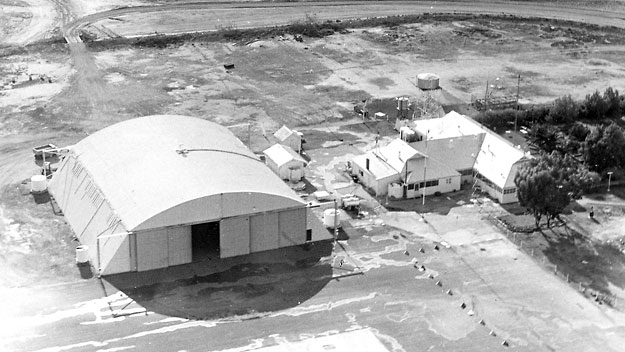
In 1928 the Commonwealth Government called for tenders for the operation
of a regular Perth-Adelaide air service. The tender was won by Norman
Brearley's West Australian Airways (WAA) with a proposal to operate three-engine,
14-passenger de Havilland D.H.66 Hercules aircraft. For the first time
in Australia, the service schedule required night flying during winter.
A night stop was also required at the half-way mark and Forrest, WA, a
remote fettlers' settlement on the trans-continental railway across the
Nullarbor Plain, was chosen as the location. The five-year contract was
awarded on 2 July 1928 and the first service departed Perth/Maylands on
26 May 1929, arriving at Adelaide/Parafield on 29 May.
WAA constructed three identical hangars to house the new Hercules (the largest aircraft in Australia at the time) at Maylands, Parafield and at Forrest. Additionally, at Forrest a hostel capable of accommodating 20 people (passengers and staff) was constructed.
The photo above shows the former WAA hangar and hostel at Forrest in February 1972, looking east away from the aerodrome movement area. Although WAA was taken over by Adelaide Airways in 1936 (and shortly afterwards incorporated in the new Australian National Airways), the buildings remained and were taken over by DCA at about that time. Part of the hostel became the Aeradio station.
Illustrating the extreme isolation of Forrest on the Nullarbor Plain near the head of the Great Australian Bight, this photo, looking east, was taken by Departmental photographer Terry Martin 'on assignment' in April 1973. The hangar and hostel are at the far right of shot, and the trans-continental railway line can be seen passing by the hangar area and off into the distance toward Adelaide.
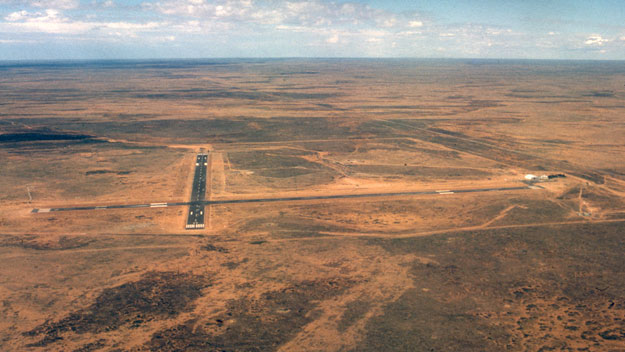
The photo
below shows the former WAA hangar from short final for Forrest's Runway
36 in August 2009. The former WAA hangars at Maylands and Forrest are
the oldest hangars still standing in Australia today. The hostel, formerly
located to the immediate right of the hangar in this shot, has been demolished
since 1972.
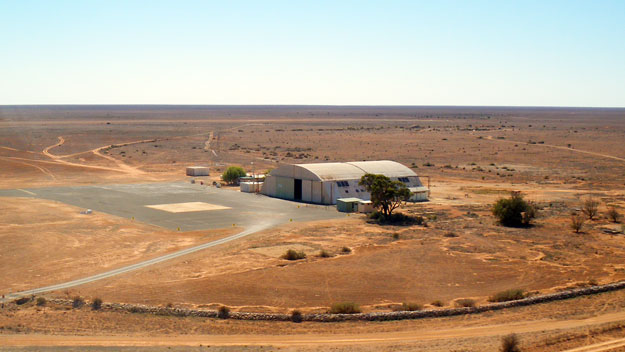
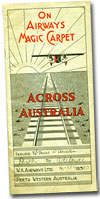
The hangar
in which our machine has come to rest is an exact replica, as to dimensions
and general characteristics, of those at Parafield (Adelaide) and Maylands
(Perth), with some additional features, of which more anon. Meanwhile,
from a hungry passenger's point of view, there are more important matters
for immediate attention. As the machine moves into the brilliantly lighted
hangar, members of Airways' ground staff become increasingly active. One
of them moves a gangway into position, hastens up it, opens the saloon
door, descends and stands aside to give a hand to passengers alighting...
Details Behind the Service.
In the hangar the machine which has brought us from Adelaide is being given a final inspection by the ground staff. Her petrol tanks have been refilled whilst we dined, and the saloon swept and garnished. Beneath the powerful electric lights she now looks as spick and span as on the day she left the workshops. Her blue-curtained, sliding windows are as spotless as the carpeted floor. Drinking filters have been replenished, tumblers rinsed. Not a chocolate wrapper remains to offend the eye. We are asked would we care for a set of tennis. The hangar floor is marked out as a court. It is only a matter of wheeling the machine out on to the tarmac. This it is explained is a perfectly simple matter. Some genius at Perth has designed a towing-fork. By this gadget the machine, whose loaded weight is between seven and eight tons, is coupled to an Airways car (garaged in the hangar) and can be wheeled as easily as a baby's perambulator. The ladies reply that they can play tennis any day, and would much prefer to be shown over the hangar.
There is much to show. Attention is directed to the refuelling apparatus. A spark-proof electric motor drives a centrifugal petrol pump from a 3,000 gallon underground tank, through an overhead pipe, to a convenient position in the centre of the hangar, near its entrance, permitting the machines to be refuelled in the shortest possible time. The overhead pipe is sloped. By this simple provision the petrol system is completely drained and all unused fuel flows back into the underground tank. Lubricant is taken to the machine in 44 gallon oil drums, on a wheeled cradle with pump attachment. Tyres of the huge wheels are inflated from 4-cylinder air pumps. Another valuable innovation is the engine rostrum. Its railed platform is eight feet above the ground. The base of this heavy structure is on the point of balance, enabling it to be wheeled about by one man. On reaching the desired position, the mere touch of a lever makes it absolutely rigid.
Floodlights and Beacons.
Mounted on a truck in another part of the hangar we saw a rotating automatic electric floodlight. This is a £400 product of Chance Bros., and is used in emergency, for night landings. Its beam of 180 degrees covers the whole landing area in a flood of light. On the roof is a rotating beacon of 2,000,000 beam candle-power, which has been picked up from as far as Cook - 138 miles. Here, too, was a stock of Sperry beacons - two-bulb automatic - for installation at emergency landing-grounds along the route. From Forrest the beacons at Deakin and Loongana (respectively 50 odd miles east and 64 miles west) are clearly visible across the flat plain.
Another interesting feature is the power-house. Here is generated the company's supply of electrical energy for lighting, heating and other purposes both at hangar and hostel. On the roofs of the two buildings are approximately one hundred floodlights, each of 200 candle-power. They are actuated by two 45 h.p. Petter's semi-Diesel engines.
The engines
are started up to give us the general effect of all this illumination.
The ladies having withdrawn, I was taken up a steep ladder to the corrugated
roof of the hangar for a close-range view of the Sperry beacon, now rotating
from an elevation of 1 ½ degrees above the horizon. During a general chat
about local water supply, I was told that this originally was brought
a distance of nearly 400 miles from Karonie (near Kalgoorlie), but Airways'
have now installed a 1 ½ inch water pipe from the hangar to the railway
siding, three-quarters of a mile distant, where a non-exhaustible bore
supplies all the requirements except that for drinking.
-oOo-
Below is another shot from ground level of the historic hangar in August 2009.
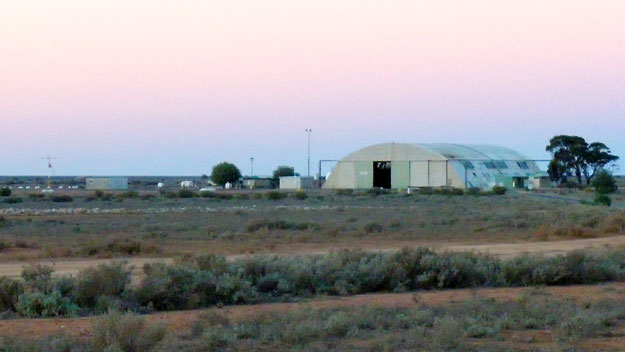
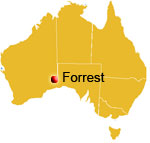
(Photos: 1-Geoff Goodall; 2-Terry Martin/CAHS collection; 3 & 4-Susie McGough)
Click here to read more about the WAA hostel at Forrest
Back to the main Airports & Aerodromes index
Back to the main Communications & Navigation index
Back to the
main Items of General Interest
index![]()
If this page appears without a menu bar at top and left, click here